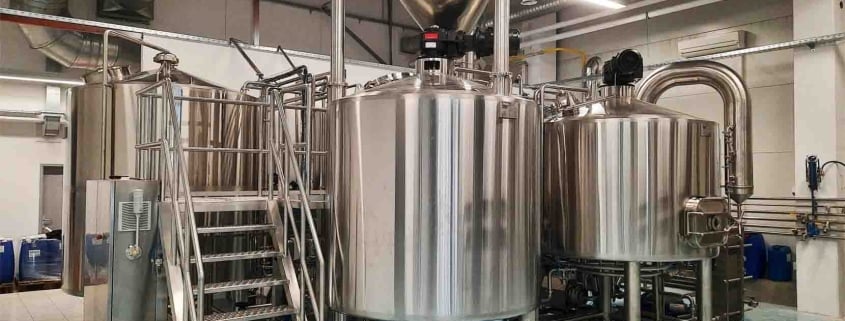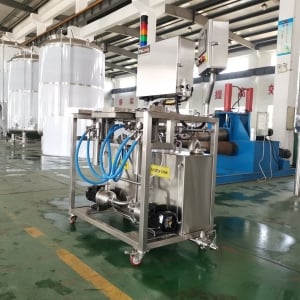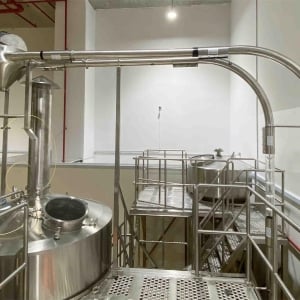Bright Beer Tanks
The journey from hops and malt to a refreshing pint of beer is a fascinating one, filled with intricate steps and transformations. But have you ever wondered what happens to your beer after it’s done fermenting? That’s where bright beer tanks come in – the gleaming vessels that polish your brew to perfection before it reaches your glass.
In this comprehensive guide, we’ll delve into the world of bright beer tanks, exploring their role in the brewing process, unpacking their features, and equipping you with the knowledge to navigate the world of bright tank selection. So, whether you’re a homebrewer with a passion for experimentation or a commercial brewer aiming to elevate your product, this guide will be your one-stop shop for bright tank brilliance.
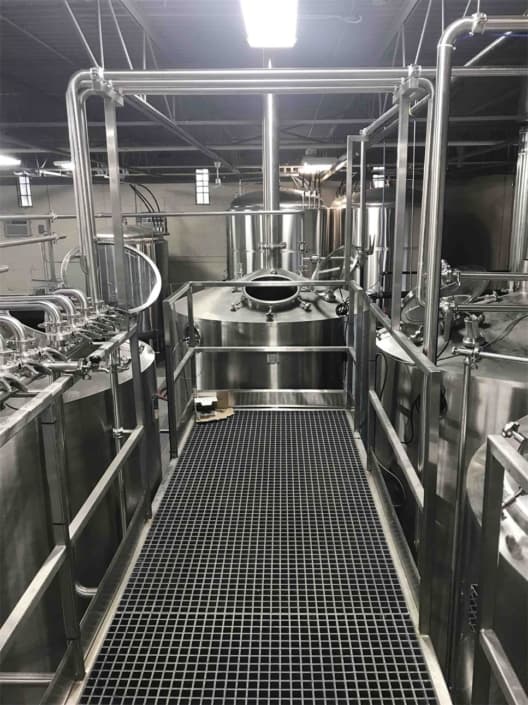
What is a Bright Beer Tank?
Imagine a giant, stainless-steel thermos – that’s essentially what a bright beer tank is. It’s a cylindrical, pressure-rated vessel designed to store beer after primary fermentation. But unlike a simple storage container, bright beer tanks play a crucial role in refining your brew.
Here’s a breakdown of their key functions:
- Carbonation: Beer gets its signature fizz from dissolved carbon dioxide (CO2). Bright tanks provide a controlled environment to carbonate your beer precisely, ensuring a consistent and delightful level of bubbles in every pour.
- Maturation: After the vigorous activity of fermentation, beer can benefit from some quiet time to mellow out and allow flavors to mature. Bright tanks offer the perfect space for this natural conditioning process, resulting in a smoother, more balanced taste.
- Clarification: Yeast and other particles can leave your beer slightly cloudy. Bright tanks can employ filtration or natural settling to remove these sediments, achieving a bright and visually appealing beer.
- Serving: In some breweries, especially smaller craft operations, bright tanks serve double duty. They can be pressurized to dispense beer directly into kegs or bottles, eliminating the need for additional transferring steps.
Bright Beer Tank Features: Unveiling the Inner Workings
Now that you understand the core functionalities of bright beer tanks, let’s explore the specific features that make them work their magic:
- Material: Stainless steel (usually 304 or 316 grade) reigns supreme in bright tank construction. This inert material is resistant to corrosion, easy to clean, and maintains optimal temperatures for beer storage.
- Capacity: Bright tanks come in a variety of sizes, ranging from compact 1-barrel options for homebrewers to massive 100-barrel tanks used in large-scale commercial breweries. The ideal size depends on your brewing volume and serving needs.
- Jacketing: Some bright tanks feature a double wall construction with a space in between (the jacket). This jacket can circulate cool glycol or hot water, allowing for precise temperature control during carbonation, maturation, and serving. Jacketed tanks offer greater control over your beer’s condition but come at a higher cost compared to single-wall tanks.
- Carbonation Stone: This device, usually made of porous fritted stainless steel, diffuses CO2 gas into the beer, facilitating even and controlled carbonation.
- Sight Glass: A small window on the tank allows brewers to visually monitor the beer’s clarity and level without opening the vessel and risking contamination.
- Pressure Gauge and Relief Valve: These components ensure safe operation by monitoring and regulating the pressure within the tank.
- Cleaning System (CIP): Bright tanks require regular cleaning and sanitation to maintain hygiene and prevent beer spoilage. A CIP system automates this process, using pumps and spray balls to circulate cleaning solutions throughout the tank.
Here’s a table summarizing the key features of bright beer tanks:
| Feature | Description |
|---|---|
| Material | Typically stainless steel (304 or 316 grade) for durability, hygiene, and temperature control. |
| Capacity | Ranges from 1-barrel for homebrewing to 100+ barrels for commercial applications. |
| Jacketing | Double-wall construction with a cooling/heating jacket for precise temperature control (optional). |
| Carbonation Stone | Facilitates even CO2 diffusion for controlled carbonation. |
| Sight Glass | Allows visual monitoring of beer clarity and level. |
| Pressure Gauge & Relief Valve | Monitors and regulates pressure for safe operation. |
| Cleaning System (CIP) | Automates cleaning and sanitation for optimal hygiene. |
The Brewing Process: Where Bright Beer Tanks Shine
- Mashing: This initial step steeps crushed grains in hot water, extracting sugars and flavors that will become the foundation of your beer.
- Lautering: The sweet wort (liquid extracted from the grains) is separated from the spent grains.
- Boiling: The wort is boiled with hops, adding bitterness, aroma, and acting as a natural preservative.
- Fermentation: Yeast is introduced, consuming the wort’s sugars and producing alcohol and CO2 as byproducts. This is where the magic of beer creation happens!
- Conditioning: After fermentation, the beer is transferred to a conditioning tank for a period of settling and maturation. Here, flavors can further develop, and some residual yeast can compact.
- Bright Tank: This is where our star player, the bright beer tank, takes center stage. The conditioned beer is transferred into the bright tank for the final stages of preparation:
- Carbonation: Precise amounts of CO2 are added using the carbonation stone, resulting in the desired level of fizz.
- Maturation (Optional): The beer can undergo additional resting time in the bright tank to allow flavors to fully harmonize and achieve a smooth taste.
- Clarification (Optional): Depending on the desired level of clarity, filtration or natural settling can occur within the bright tank to remove any remaining yeast or particles.
- Packaging & Distribution: The finished, sparkling-clear beer is packaged into kegs, bottles, or cans for enjoyment by thirsty consumers!
Bright Beer Tanks: The Bridge Between Brewing and Serving
As you can see, bright beer tanks play a crucial role in bridging the gap between the brewing process and the final product enjoyed by beer enthusiasts. They ensure consistent carbonation, enhance flavor profiles, and achieve a visually appealing clarity, all contributing to a high-quality drinking experience.
Bright Beer Tank Options: Choosing the Right Fit
The world of bright beer tanks offers a variety of options to suit different needs and budgets. Here’s a breakdown of some key factors to consider when choosing your bright tank:
- Capacity: As mentioned earlier, size is a critical consideration. Homebrewers can find compact 1-barrel options, while commercial breweries may require massive tanks to meet their production demands.
- Jacketing: Jacketed tanks offer superior temperature control but come at a higher cost. If precise temperature management is essential for your brewing process, a jacketed tank is a worthwhile investment. Single-wall tanks are a more budget-friendly option for brewers who prioritize cost over intricate temperature control.
- Features: Consider the additional features you might need. Does a sight glass for easy monitoring seem valuable? Is a CIP system for automated cleaning crucial for your operation?
Here’s a table outlining different bright tank configurations to help you compare options:
| Feature | Single-Wall Tank | Jacketed Tank |
|---|---|---|
| Temperature Control | Limited ( relies on ambient temperature) | Precise control through cooling/heating jacket |
| Cost | More affordable | Higher cost due to additional construction |
| Suitability | Ideal for homebrewers or smaller breweries with less strict temperature requirements | Perfect for commercial breweries or operations requiring precise temperature control for specific beer styles. |
Remember, the ideal bright tank for you depends on your specific brewing goals, production volume, and budget.
Bright Beer Tank Suppliers & Price Range
The brewing equipment market boasts a wide range of bright tank suppliers catering to both homebrew and commercial needs. Here are some factors to consider when choosing a supplier:
- Reputation: Look for established companies with a proven track record of quality and customer service. Reading online reviews and consulting with fellow brewers can be helpful in this regard.
- Warranty: A solid warranty protects your investment and demonstrates the manufacturer’s confidence in their product.
- Customization Options: Do you have specific needs for size, features, or materials? Some suppliers offer customization options to tailor the bright tank to your exact requirements.
Here’s a table providing a general idea of bright beer tank prices based on capacity and features:
| Capacity | Jacketed Tank | Single-Wall Tank |
|---|---|---|
| 1-Barrel (Homebrew) | $1,000 – $2,000 | $500 – $1,000 |
| 10-Barrel (Craft Brewery) | $5,000 – $10,000 | $3,000 – $6,000 |
| 100-Barrel (Large Brewery) | $30,000 – $50,000+ | $20,000 – $40,000+ |
So, you’ve chosen the perfect bright beer tank for your brewing needs. Now comes the crucial task of installing it properly, operating it efficiently, and maintaining it meticulously to ensure optimal performance and longevity.
Installation:
- Planning is Key: Before installation day arrives, ensure you have a designated space for your bright tank that meets weight capacity requirements and allows for easy access for cleaning and maintenance. Also, plan for the utilities needed, such as a CO2 source, water supply, and drainage.
- Professional Help: For larger and more complex bright tank setups, especially in commercial breweries, consider seeking assistance from experienced equipment installation professionals. They’ll ensure proper placement, connection of utilities, and adherence to safety regulations.
Operation:
- Following the Manual: Each bright tank model might have slight operational nuances. Always refer to the manufacturer’s instructions for detailed guidance on proper operation, including filling procedures, carbonation techniques, and temperature control settings (if applicable to your tank).
- Sanitization is Paramount: Maintaining a clean and sanitized environment is vital to prevent beer spoilage and contamination. Develop a regular cleaning routine for your bright tank, following the manufacturer’s recommended cleaning solutions and procedures. Most bright tanks are equipped with CIP systems for automated cleaning, making this process more efficient.
- Carbonation Control: CO2 pressure plays a critical role in achieving the desired level of fizz in your beer. Learn how to properly adjust the pressure in your bright tank using the pressure gauge and regulator to achieve perfect carbonation for your chosen beer style.
Maintenance:
- Regular Inspections: Develop a habit of visually inspecting your bright tank regularly for any signs of leaks, damage, or malfunctioning components. Early detection and prompt repair will prevent bigger problems down the road.
- Preventative Maintenance: Schedule periodic maintenance checks, which may involve tasks like replacing gaskets or lubricating valves. Following a preventative maintenance plan will minimize downtime and ensure the smooth operation of your bright tank.
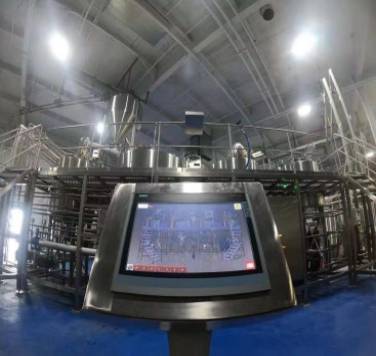
Here’s a table summarizing the key steps for bright beer tank installation, operation, and maintenance:
| Stage | Description |
|---|---|
| Installation | Planning, space allocation, utility consideration, professional help for complex setups. |
| Operation | Following the manufacturer’s instructions, prioritizing sanitation, CO2 pressure control for carbonation. |
| Maintenance | Regular inspections, preventative maintenance checks, prompt repairs when needed. |
By following these guidelines, you can ensure your bright beer tank remains a reliable and valuable asset in your brewing process, delivering perfectly conditioned beer for years to come.
Choosing the Right Bright Beer Tank Supplier
Selecting the right supplier for your bright beer tank is a crucial decision. Here’s a roadmap to guide you through the process:
- Identify Your Needs: Start by clearly defining your requirements. Consider factors like the brewing volume you anticipate, the specific features you need (jacketing, CIP system, etc.), and of course, your budget.
- Research Potential Suppliers: The internet is a treasure trove of information. Utilize search engines and online directories to identify reputable bright tank suppliers in your region or preferred brands. Look for companies with a strong online presence and positive customer reviews.
- Compare Offerings: Once you’ve shortlisted a few potential suppliers, delve deeper into their product catalogs and pricing structures. Pay attention to the features offered by each tank model, the quality of materials used, and the warranty provided. Don’t hesitate to contact suppliers directly to inquire about specific details or request quotes.
- Customer Service Matters: Excellent customer service is a hallmark of a reliable supplier. Look for companies that offer responsive communication channels, readily answer your questions, and provide ongoing support after the sale.
Here’s a table outlining key questions to consider when evaluating bright beer tank suppliers:
| Question | Importance |
|---|---|
| Reputation and Experience | A well-established company with a proven track record inspires confidence. |
| Product Quality | Look for durable materials, reputable brands, and features that align with your needs. |
| Warranty Coverage | A solid warranty demonstrates the manufacturer’s faith in their product quality. |
| Customization Options | Does the supplier offer modifications to cater to your specific requirements? |
| Customer Service | Responsive communication, helpful guidance, and ongoing support are invaluable. |
| Pricing and Payment Options | Compare pricing structures and inquire about financing options if needed. |

